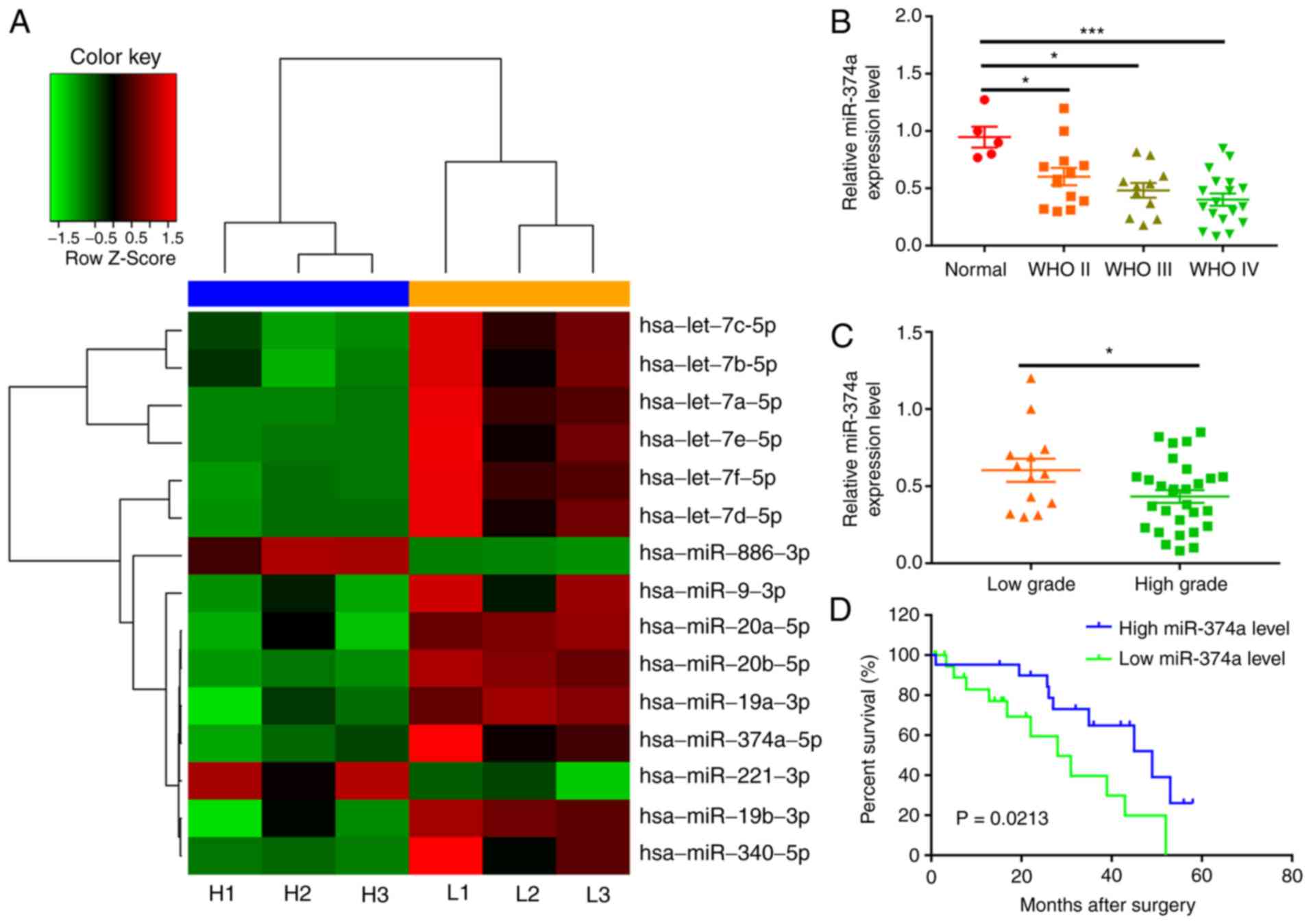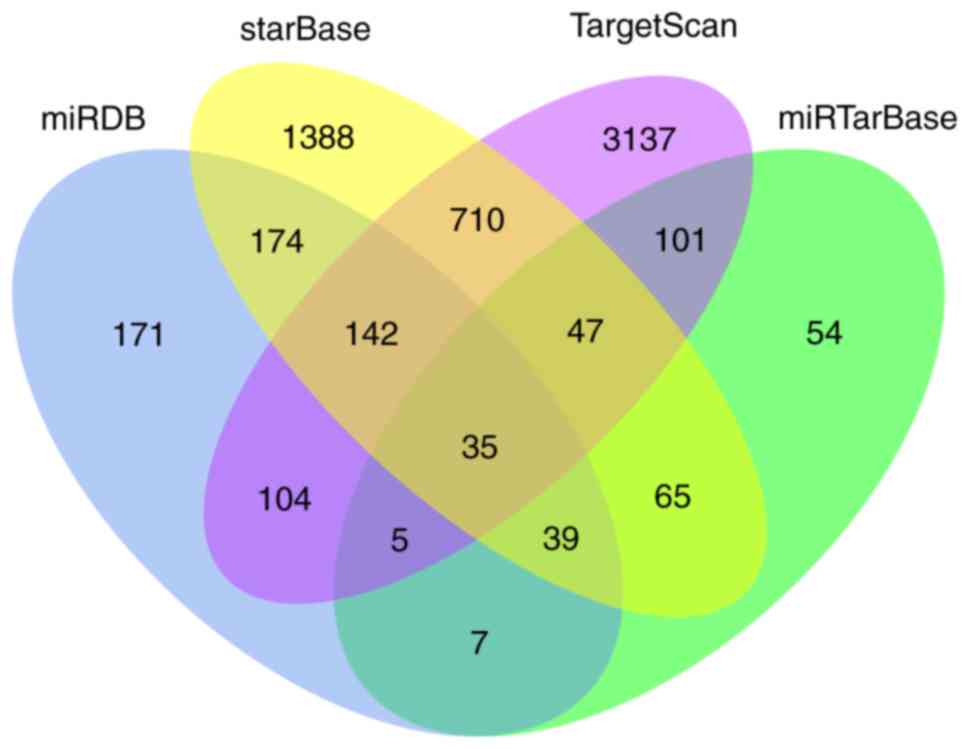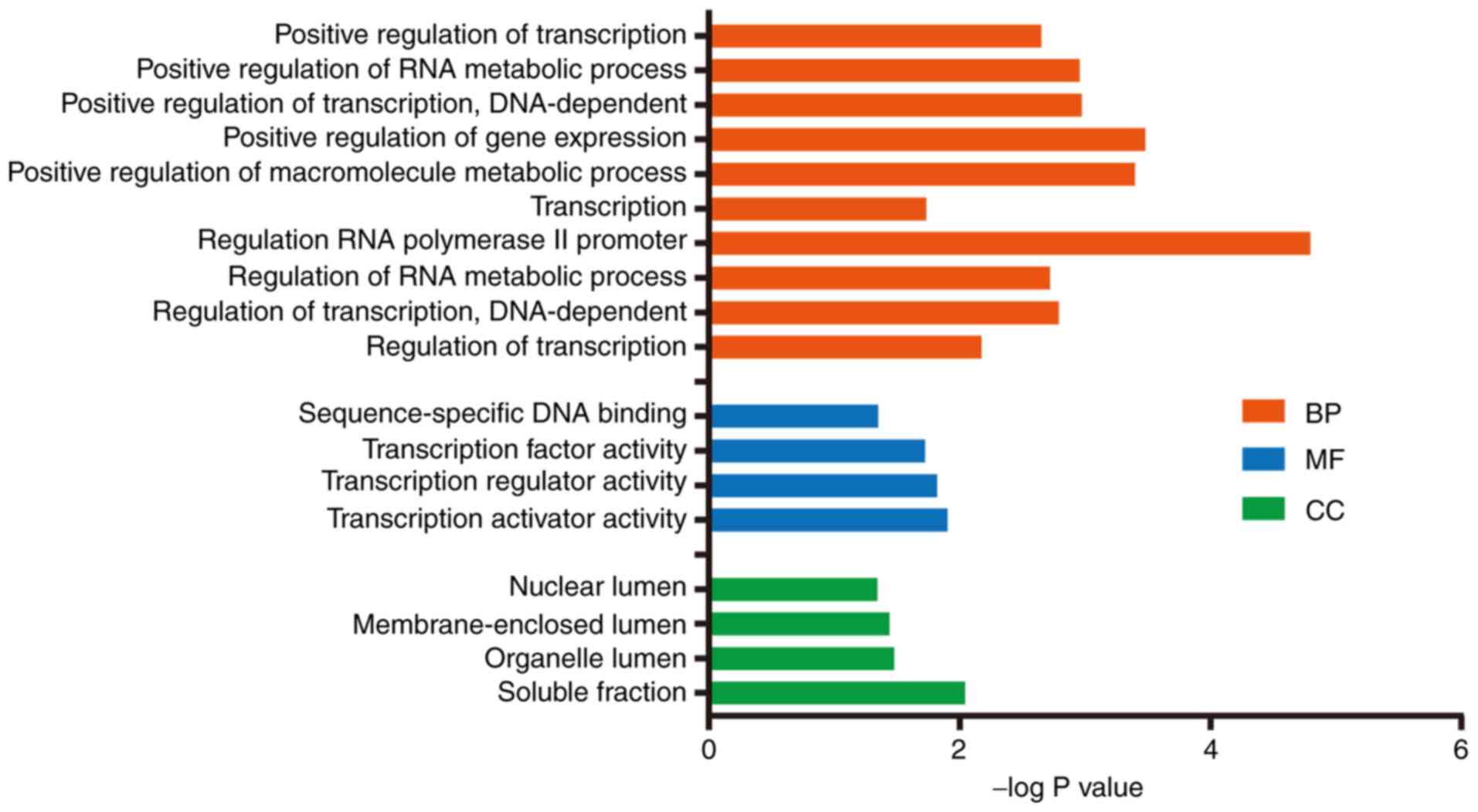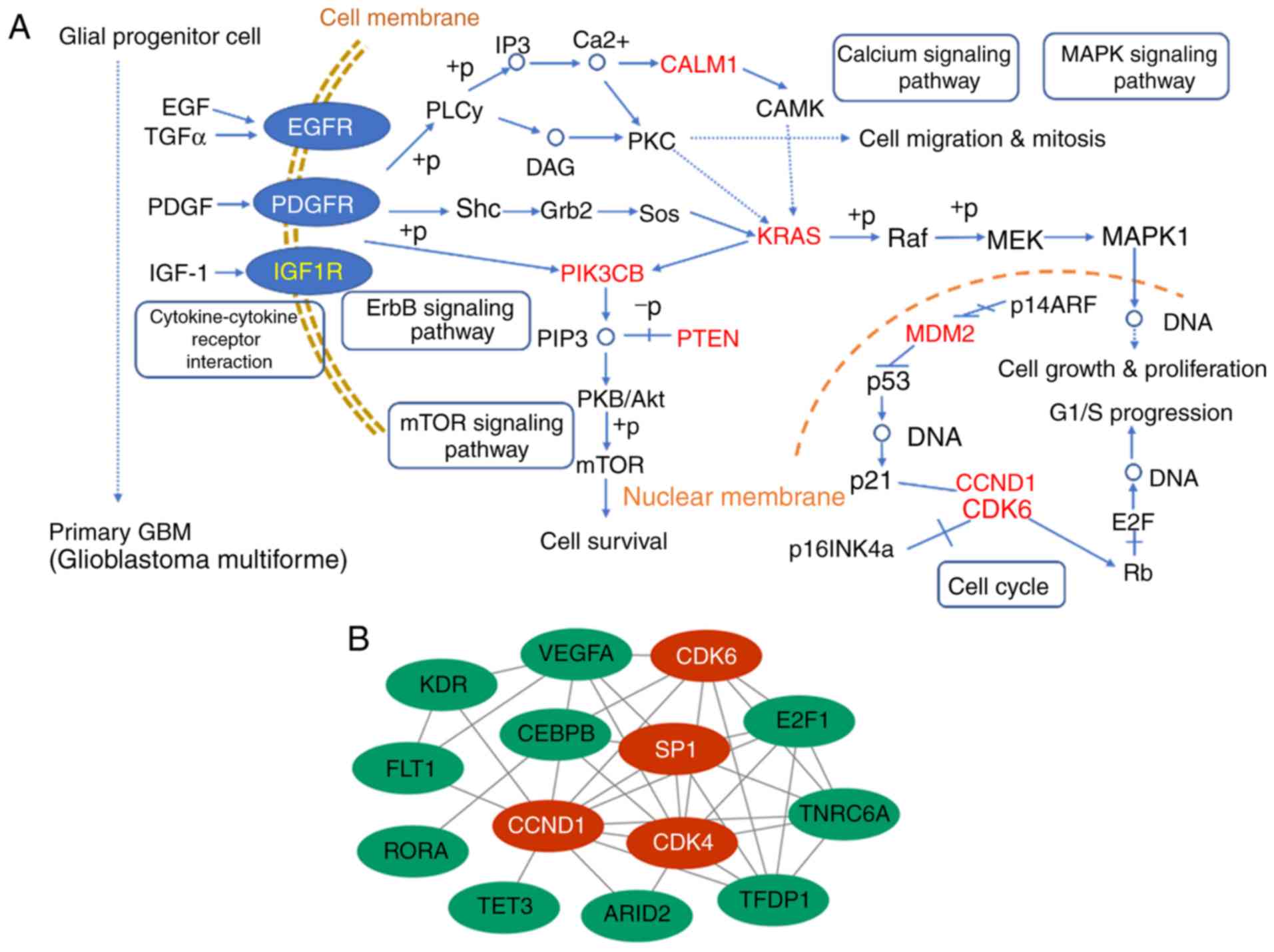|
1
|
Ohgaki H and Kleihues P: Epidemiology and
etiology of gliomas. Acta Neuropathol. 109:93–108. 2005. View Article : Google Scholar : PubMed/NCBI
|
|
2
|
Schwartzbaum JA, Fisher JL, Aldape KD and
Wrensch M: Epidemiology and molecular pathology of glioma. Nat Clin
Pract Neurol. 2:494–503. 2006. View Article : Google Scholar : PubMed/NCBI
|
|
3
|
Louis DN, Perry A, Reifenberger G, von
Deimling A, Figarella-Branger D, Cavenee WK, Ohgaki H, Wiestler OD,
Kleihues P and Ellison DW: The 2016 World Health Organization
classification of tumors of the central nervous system: A summary.
Acta Neuropathologica. 131:803–820. 2016. View Article : Google Scholar : PubMed/NCBI
|
|
4
|
Stupp R, Hegi ME, Mason WP, van den Bent
MJ, Taphoorn MJ, Janzer RC, Ludwin SK, Allgeier A, Fisher B,
Belanger K, et al: Effects of radiotherapy with concomitant and
adjuvant temozolomide versus radiotherapy alone on survival in
glioblastoma in a randomised phase III study: 5-year analysis of
the EORTC-NCIC trial. Lancet Oncol. 10:459–466. 2009. View Article : Google Scholar : PubMed/NCBI
|
|
5
|
Delgado-López PD and Corrales-García EM:
Survival in glioblastoma: A review on the impact of treatment
modalities. Clin Transl Oncol. 18:1062–1071. 2016. View Article : Google Scholar : PubMed/NCBI
|
|
6
|
Kleihues P, Burger PC, Aldape KD, et al;
Louis DN, Ohgaki H, Wiestler OD and Cavenee WK: WHO classification
of tumours of the central nervous system. 2007.
|
|
7
|
Abrunhosa-Branquinho AN, Bar-Deroma R,
Collette S, Clementel E, Liu Y, Hurkmans CW, Feuvret L, Van Beek K,
van den Bent M, Baumert BG and Weber DC: Radiotherapy quality
assurance for the RTOG 0834/EORTC 26053-22054/NCIC CTG CEC.1/CATNON
intergroup trial ‘concurrent and adjuvant temozolomide chemotherapy
in newly diagnosed non-1p/19q deleted anaplastic glioma’:
Individual case review analysis. Radiother Oncol. 127:292–298.
2018. View Article : Google Scholar : PubMed/NCBI
|
|
8
|
Zhou L, Liu F, Wang X and Ouyang G: The
roles of microRNAs in the regulation of tumor metastasis. Cell
Biosci. 5:322015. View Article : Google Scholar : PubMed/NCBI
|
|
9
|
Aakula A, Kohonen P, Leivonen SK, Mäkelä
R, Hintsanen P, Mpindi JP, Martens-Uzunova E, Aittokallio T,
Jenster G, Perälä M, et al: Systematic identification of MicroRNAs
that impact on proliferation of prostate cancer cells and display
changed expression in tumor tissue. Eur Urol. 69:1120–1128. 2016.
View Article : Google Scholar : PubMed/NCBI
|
|
10
|
Zhu QN, Renaud H and Guo Y:
Bioinformatics-based identification of miR-542-5p as a predictive
biomarker in breast cancer therapy. Hereditas. 155:172018.
View Article : Google Scholar : PubMed/NCBI
|
|
11
|
Man HB, Bi WP and Man HH: Decreased
microRNA-198 expression and its prognostic significance in human
glioma. Genet Mol Res. 15–2016. View Article : Google Scholar
|
|
12
|
Zhang J, Lv J, Zhang F, Che H, Liao Q,
Huang W, Li S and Li Y: MicroRNA-211 expression is down-regulated
and associated with poor prognosis in human glioma. J Neurooncol.
133:553–559. 2017. View Article : Google Scholar : PubMed/NCBI
|
|
13
|
Yuan GQ, Wei NL, Mu LY, Wang XQ, Zhang YN,
Zhou WN and Pan YW: A 4-miRNAs signature predicts survival in
glioblastoma multiforme patients. Cancer Biomark. 20:443–452. 2017.
View Article : Google Scholar : PubMed/NCBI
|
|
14
|
Zhou MH, Zhou HW, Liu M and Sun JZ: The
role of miR-92b in cholangiocarcinoma patients. Int J Biol Markers.
33:293–300. 2018. View Article : Google Scholar : PubMed/NCBI
|
|
15
|
Livak KJ and Schmittgen TD: Analysis of
relative gene expression data using real-time quantitative PCR and
the 2(-Delta Delta C(T)) method. Methods. 25:402–408. 2001.
View Article : Google Scholar : PubMed/NCBI
|
|
16
|
Sarrion I, Milian L, Juan G, Ramon M,
Furest I, Carda C, Cortijo Gimeno J and Mata Roig M: Role of
circulating miRNAs as biomarkers in idiopathic pulmonary arterial
hypertension: Possible relevance of miR-23a. Oxid Med Cell Longev.
2015:7928462015. View Article : Google Scholar : PubMed/NCBI
|
|
17
|
Ekimler S and Sahin K: Computational
Methods for MicroRNA Target Prediction[J]. Genes. 5(3): 671–683.
2014. View Article : Google Scholar : PubMed/NCBI
|
|
18
|
Hsu SD, Lin FM, Wu WY, Liang C, Huang WC,
Chan WL, Tsai WT, Chen GZ, Lee CJ, Chiu CM, et al: miRTarBase: A
database curates experimentally validated microRNA-target
interactions. Nucleic Acids Res. 39:(Database Issue). D163–D169.
2011. View Article : Google Scholar : PubMed/NCBI
|
|
19
|
Li JH, Liu S, Zhou H, Qu LH and Yang JH:
starBase v2.0: Decoding miRNA-ceRNA, miRNA-ncRNA and protein-RNA
interaction networks from large-scale CLIP-Seq data. Nucleic Acids
Res. 42:(Database Issue). D92–D97. 2014. View Article : Google Scholar : PubMed/NCBI
|
|
20
|
Vlachos IS, Kostoulas N, Vergoulis T,
Georgakilas G, Reczko M, Maragkakis M, Paraskevopoulou MD,
Prionidis K, Dalamagas T and Hatzigeorgiou AG: DIANA miRPath v.2.0:
Investigating the combinatorial effect of microRNAs in pathways.
Nucleic Acids Res. 40:W498–W504. 2012. View Article : Google Scholar : PubMed/NCBI
|
|
21
|
Wong N and Wang X: miRDB: An online
resource for microRNA target prediction and functional annotations.
Nucleic eAcids Rse. 43:(Database Issue). D146–D152. 2015.
View Article : Google Scholar
|
|
22
|
Papadopoulos GL, Alexiou P, Maragkakis M,
Reczko M and Hatzigeorgiou AG: DIANA-mirPath: Integrating human and
mouse microRNAs in pathways. Bioinformatics. 25:1991–1993. 2009.
View Article : Google Scholar : PubMed/NCBI
|
|
23
|
Fazi B, Felsani A, Grassi L, Moles A, D
Andrea D, Toschi N, Sicari D, De Bonis P, Anile C, Guerrisi MG, et
al: The transcriptome and miRNome profiling of glioblastoma tissues
and peritumoral regions highlights molecular pathways shared by
tumors and surrounding areas and reveals differences between
short-term and long-term survivors. Oncotarget. 6:22526–22552.
2015. View Article : Google Scholar : PubMed/NCBI
|
|
24
|
Dai J, Li Q, Bing Z, Zhang Y, Niu L, Yin
H, Yuan G and Pan Y: Comprehensive analysis of a microRNA
expression profile in pediatric medulloblastoma. Mol Med Rep.
15:4109–4115. 2017. View Article : Google Scholar : PubMed/NCBI
|
|
25
|
Nohata N, Hanazawa T, Kinoshita T, Okamoto
Y and Seki N: MicroRNAs function as tumor suppressors or oncogenes:
Aberrant expression of microRNAs in head and neck squamous cell
carcinoma. Auris Nasus Larynx. 40:143–149. 2013. View Article : Google Scholar : PubMed/NCBI
|
|
26
|
Babashah S and Soleimani M: The oncogenic
and tumour suppressive roles of microRNAs in cancer and apoptosis.
Eur J Cancer. 47:1127–1137. 2011. View Article : Google Scholar : PubMed/NCBI
|
|
27
|
Chen Y, Fu LL, Wen X, Liu B, Huang J, Wang
JH and Wei YQ: Oncogenic and tumor suppressive roles of microRNAs
in apoptosis and autophagy. Apoptosis. 19:1177–1189. 2014.
View Article : Google Scholar : PubMed/NCBI
|
|
28
|
Xue L, Wang Y, Yue S and Zhang J: The
expression of miRNA-221 and miRNA-222 in gliomas patients and their
prognosis. Neurol Sci. 38:67–73. 2017. View Article : Google Scholar : PubMed/NCBI
|
|
29
|
Ji Y, Wei Y, Wang J, Gong K, Zhang Y and
Zuo H: Correlation of microRNA-10b upregulation and poor prognosis
in human gliomas. Tumour Biol. 36:6249–6254. 2015. View Article : Google Scholar : PubMed/NCBI
|
|
30
|
Li N, Yang L, Wang H, Yi T, Jia X, Chen C
and Xu P: MiR-130a and MiR-374a function as novel regulators of
cisplatin resistance in human ovarian cancer A2780 cells. PLoS One.
10:e01288862015. View Article : Google Scholar : PubMed/NCBI
|
|
31
|
Wu H, Liu Y, Shu XO and Cai Q: MiR-374a
suppresses lung adenocarcinoma cell proliferation and invasion by
targeting TGFA gene expression. Carcinogenesis. 37:567–575. 2016.
View Article : Google Scholar : PubMed/NCBI
|
|
32
|
Slattery ML, Pellatt AJ, Lee FY, Herrick
JS, Samowitz WS, Stevens JR, Wolff RK and Mullany LE: Infrequently
expressed miRNAs influence survival after diagnosis with colorectal
cancer. Oncotarget. 8:83845–83859. 2017. View Article : Google Scholar : PubMed/NCBI
|
|
33
|
Xu X, Wang W, Su N, Zhu X, Yao J, Gao W,
Hu Z and Sun Y: miR-374a promotes cell proliferation, migration and
invasion by targeting SRCIN1 in gastric cancer. FEBS Lett.
589:407–413. 2015. View Article : Google Scholar : PubMed/NCBI
|
|
34
|
Pan Z, Shi Z, Wei H, Sun F, Song J, Huang
Y, Liu T and Mao Y: Magnetofection based on superparamagnetic iron
oxide nanoparticles weakens glioma stem cell proliferation and
invasion by mediating high expression of MicroRNA-374a. J Cancer.
7:1487–1496. 2016. View Article : Google Scholar : PubMed/NCBI
|
|
35
|
Zhang C, Zhang C, Ma M and Dai D:
Three-microRNA signature identified by bioinformatics analysis
predicts prognosis of gastric cancer patients. World J
Gastroenterol. 24:1206–1215. 2018. View Article : Google Scholar : PubMed/NCBI
|
|
36
|
Späth F, Andersson U, Dahlin AM, Langseth
H, Hovig E, Johannesen TB, Grankvist K, Björkblom B, Wibom C and
Melin B: Pre-diagnostic serum levels of EGFR and ErbB2 and genetic
glioma risk variants: A nested case-control study. Tumour Biol.
37:11065–11072. 2016. View Article : Google Scholar : PubMed/NCBI
|
|
37
|
Liu R, Qu Y, Chen L, Pu J, Ma S, Zhang X,
Yang Q, Shi B, Hou P and Ji M: Genomic copy number gains of ErbB
family members predict poor clinical outcomes in glioma patients.
Oncotarget. 8:92275–92288. 2017.PubMed/NCBI
|
|
38
|
Wang N, Zhang Q, Luo L, Ning B and Fang Y:
β-asarone inhibited cell growth and promoted autophagy via
P53/Bcl-2/Bclin-1 and P53/AMPK/mTOR pathways in Human Glioma U251
cells. J Cell Physiol. 233:24342018. View Article : Google Scholar : PubMed/NCBI
|
|
39
|
Diehl JA: Cycling to cancer with cyclin
D1. Cancer Biol Ther. 1:226–231. 2002. View
Article : Google Scholar : PubMed/NCBI
|
|
40
|
Shintani M, Okazaki A, Masuda T, Kawada M,
Ishizuka M, Doki Y, Weinstein IB and Imoto M: Overexpression of
cyclin DI contributes to malignant properties of esophageal tumor
cells by increasing VEGF production and decreasing Fas expression.
Anticancer Res. 22:639–647. 2002.PubMed/NCBI
|
|
41
|
Yin L, Li H, Liu W, Yao Z, Cheng Z, Zhang
H and Zou H: A highly potent CDK4/6 inhibitor was rationally
designed to overcome blood brain barrier in gliobastoma therapy.
Eur J Med Chem. 144:1–28. 2018. View Article : Google Scholar : PubMed/NCBI
|
|
42
|
Bajpai R and Nagaraju GP: Specificity
protein 1: Its role in colorectal cancer progression and
metastasis. Crit Rev Oncol Hematol. 113:1–7. 2017. View Article : Google Scholar : PubMed/NCBI
|
|
43
|
Guan H, Cai J, Zhang N, Wu J, Yuan J, Li J
and Li M: Sp1 is upregulated in human glioma, promotes
MMP-2-mediated cell invasion and predicts poor clinical outcome.
Int J Cancer. 130:593–601. 2012. View Article : Google Scholar : PubMed/NCBI
|


















